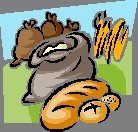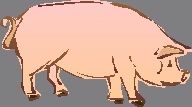Until relatively, recently, every family kept a pig, also chickens and rabbits. Pigeons were another source of meat. In the villages pigs were kept in small cellars below the houses. Chickens ran loose in the streets, but came home to roost each evening in structures that looked like a large stone carbuncle on the sides of houses. The only clue in modern times to their former use are the small holes about the size of a dinner plate, through which the chickens entered or departed their home.

